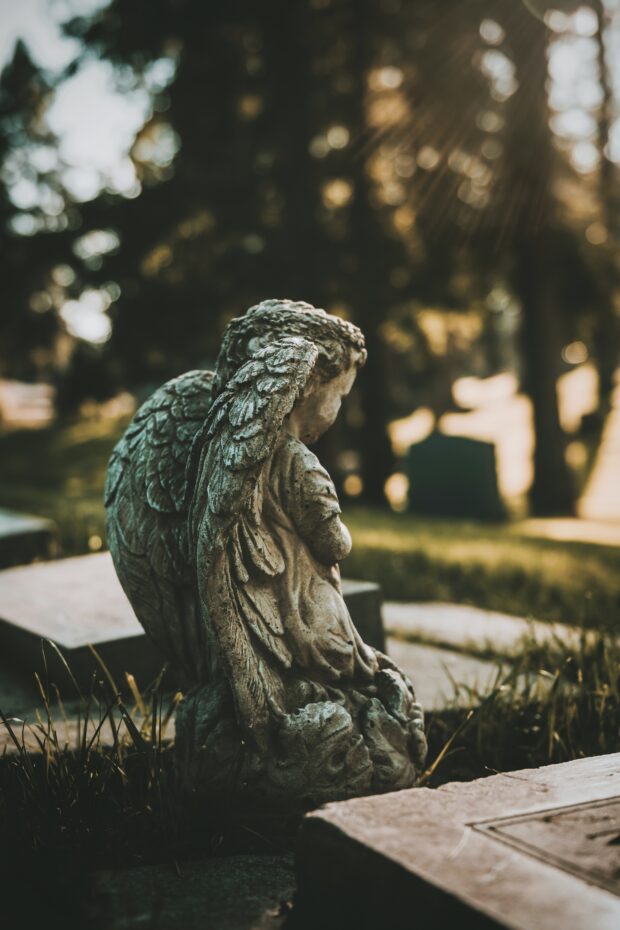You have no items in your cart. Want to get some nice things?
Go shopping
The Mount, Wharton’s home in Lenox, Massachusetts, features a pet cemetery with six little gravestones on a wooded knoll, marking the graves of . . . . four of the dozens of dogs Wharton had. Wharton could see the cemetery from her window as she wrote (every day until at least 11, lying in bed), surrounded by her living dogs and gazing out at her dead.
In 1937, when her favorite dog Linky died, Wharton wrote to William Royall Tyler that she had always “understood” what dogs “said.” “I have always been like that about dogs, ever since I was a baby. We really communicated with each other—& no one had such wise things to say as Linky.” (E. Temple, LitHub Jan. 24, 2017)
Dear Sister-in-Law,
Like Edith Wharton, we also have a pet graveyard. Ours does not have headstones, although last summer while I was doing some yard work, I put a brick on each of the graves so I would remember where they were. You can see the graveyard from our living room window and I can point it out to you next time you are here if you like.
Why do we bury our pets, you might ask. About half of them have died here at home, and, well, we can’t not bury them. I have heard, however, that some people leave them outside on the ground where scavengers can make the most of their bodies and I can see that. We also bring home the ones that have been euthanized at the vet’s, to give them equal treatment but also to give ourselves a quiet moment with them. You sister takes this seriously and once injured her knee and required surgery after holding our dog Cinnamon on the way home from her euthanasia.
Some thirty years ago when we began burying our pets, we didn’t have a plan. At first we buried our loved ones and planted a tree or rose bush near the grave. That became a problem when the rose bush died, or when we wanted to add on to the house and Maggie was in the way. Then we thought maybe we would just pick a “special” location. Now neither of us can remember where Ben is buried, although I’m pretty sure he is somewhere near Sam.
Sam is buried where he hung out a lot before his death and where he actually died. That was an easy one, except that we have since had a die-off of trees due to beetle kill and now I’m not real sure where Sam is buried because the landmarks are gone. Sometimes we let convenience influence our choice. Sadie, our big German shepherd, is buried in the side of a pre-existing pit that has been used for trash and was once a cesspool. Your sister still chides me about this and I admit it was lacking in sensitivity but Sadie was really big.
Cats, on the other hand, are easy to bury. Before we had cat yards, several of our cats simply disappeared never to be seen nor heard from again. We miss them as much as the ones we have buried, which calls into question the whole need for burying in the first place. Still, getting back to the graveyard in our front yard, when our old dog Agate passes on, he will be put with his buddies Jackson, Powder, Tiger lily, and Cinnamon. They were a pack when they were alive and we can’t imagine him any other place. So, I guess we are just as sentimental as Edith. But, you knew that.
*******
Dear Sister-in-Law:
“I wanted to give you an update on our dog burials. Your sister and I recently hired a local man named Jame to clean up our yard. He is very thorough to the point of being obsessive. He first cleaned around my shop and did a wonderful job. You would not recognize it. Now he is getting rid of the ragweed around the house because of your sister’s allergies.
This morning I looked out the living room window and saw this stack of bricks (see photo). These I had placed on each site where we had buried a dog so that we could remember where they were. He had neatly stacked the bricks, dug up the ragweed, and raked the ground. The yard is nice and tidy and I have no idea where the graves are.
About Mardith Louisell
Lake Superior in Duluth, Minnesota, where Mardith Louisell was raised, continues to affect everything she writes as does her previous child welfare social work. Her fiction, essays and memoir can be found in South Dakota Review, Solstice Literary Magazine, Persimmon Tree, and Smokelong Quarterly and in the anthologies: Italy, A Love Story, The House on Via Gombito Street, and Best Travel Writing 2012. Beside Myself, a book of flash fiction with a single narrator is her current project. Her short story, “Had They Learned about Jayne Mansfield?” is her favorite title. She lives in San Francisco.




